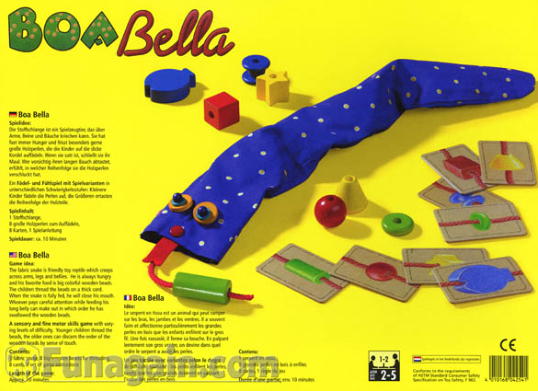 |
| Tactile discrimination, sequencing and lacing in one fun game. |
I love the German-made Haba brand games. I have quite a few of them and they have always been of a very good quality, often including wooden pieces. This is an unusual feel-and-find/lacing type game like none other that I have, and one of my favorites.
The game includes a 1' 6" long cloth snake with a 2' 6" long "tongue" (a piece of cord) that is sewed to the (inside) tail-end of the snake. This tongue serves as a lacing cord for the eight blocks. The blocks are larger (see my image below) and have nice big holes, so this one is good for beginners. The holes are smooth so the cord will not catch as you lace. For each block there is a matching card. Here is a view from the back of the box.
The object of the game is to string the blocks on the cord and then pull the cloth snake over them so that they are hidden from sight within the snake. The snake is kind of like a sock - you can either pull it over the beads or push the sock down to the bottom so the blocks are revealed. The nose that you see on the snake above is a snap so you can snap the snake shut if you want.
After stringing the beads and they are out of sight, start at one end and feel the first bead. Once you know what it is, get the matching card and lay it in front of you. Then feel the next bead and find the matching card. Lay that card next to the first one. After feeling all eight beads and lining up the eight cards to match the bead sequence, open the snake, push down the cloth so you can see all the beads, and check your cards with the beads. Each of the wooden beads is a different shape and you can see them all above. There are four colors - red, green, blue, and yellow.
Try this:
- Talk about the blocks and feel them beforehand to acquaint the individual with what they will be feeling later without sight.
- Start with fewer blocks and work your way up to eight.
- String the blocks and cover them with the snake without showing them to the player first, for a greater challenge.
- Line the cards up first and ask the individual to string the beads in that sequence. Remember to start at the far right instead of the left as you string, since the cord is sewed into place.
- Line up the cards and then line up the blocks in a matching sequence before trying it without vision.
- Turn the blocks in-hand while orienting the hole for lacing.
- Place two cards in front of the individual and then one block. Ask them to pick the matching card.
- Place all the blocks on the table and give the individual one card at a time and ask him to find that block in the pile.
- Work on visual discrimination, visual closure, spatial relations, eye-hand coordination, manual dexterity, in-hand manipulation, coordinated use of both hands, sequencing, tactile discrimination, haptic memory, process skills, executive functioning skills, play and leisure exploration and participation
In the box: Cloth snake, 8 wooden blocks, 8 block cards



No comments:
Post a Comment
Thank you for taking the time to comment.